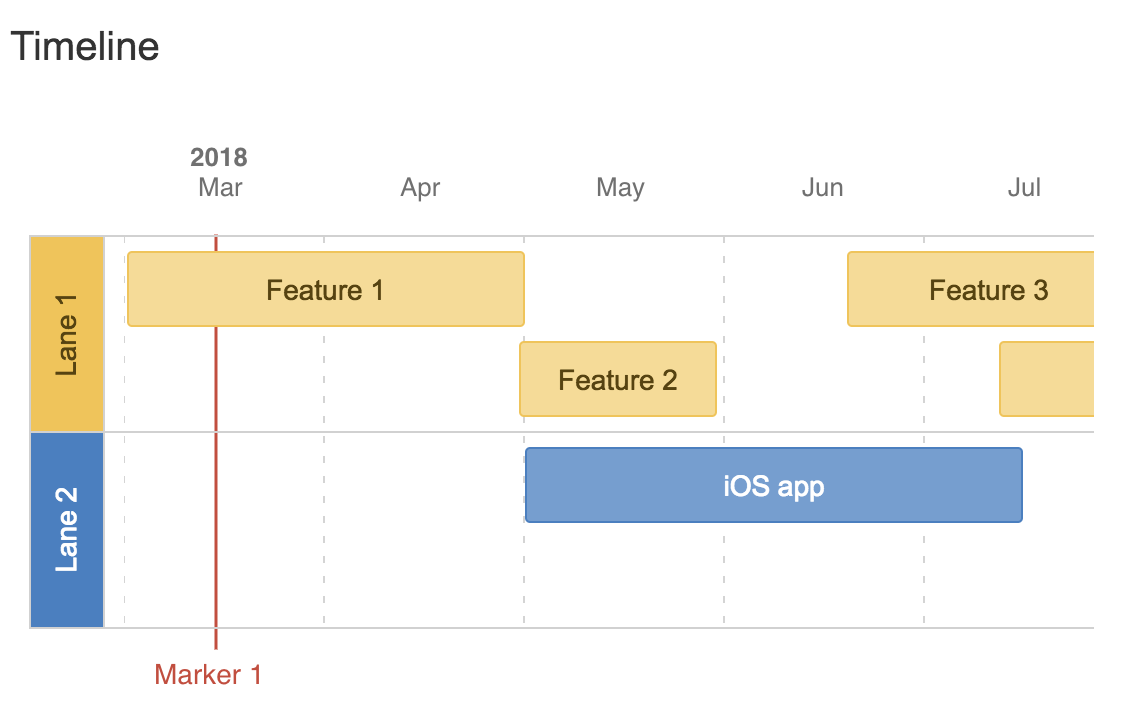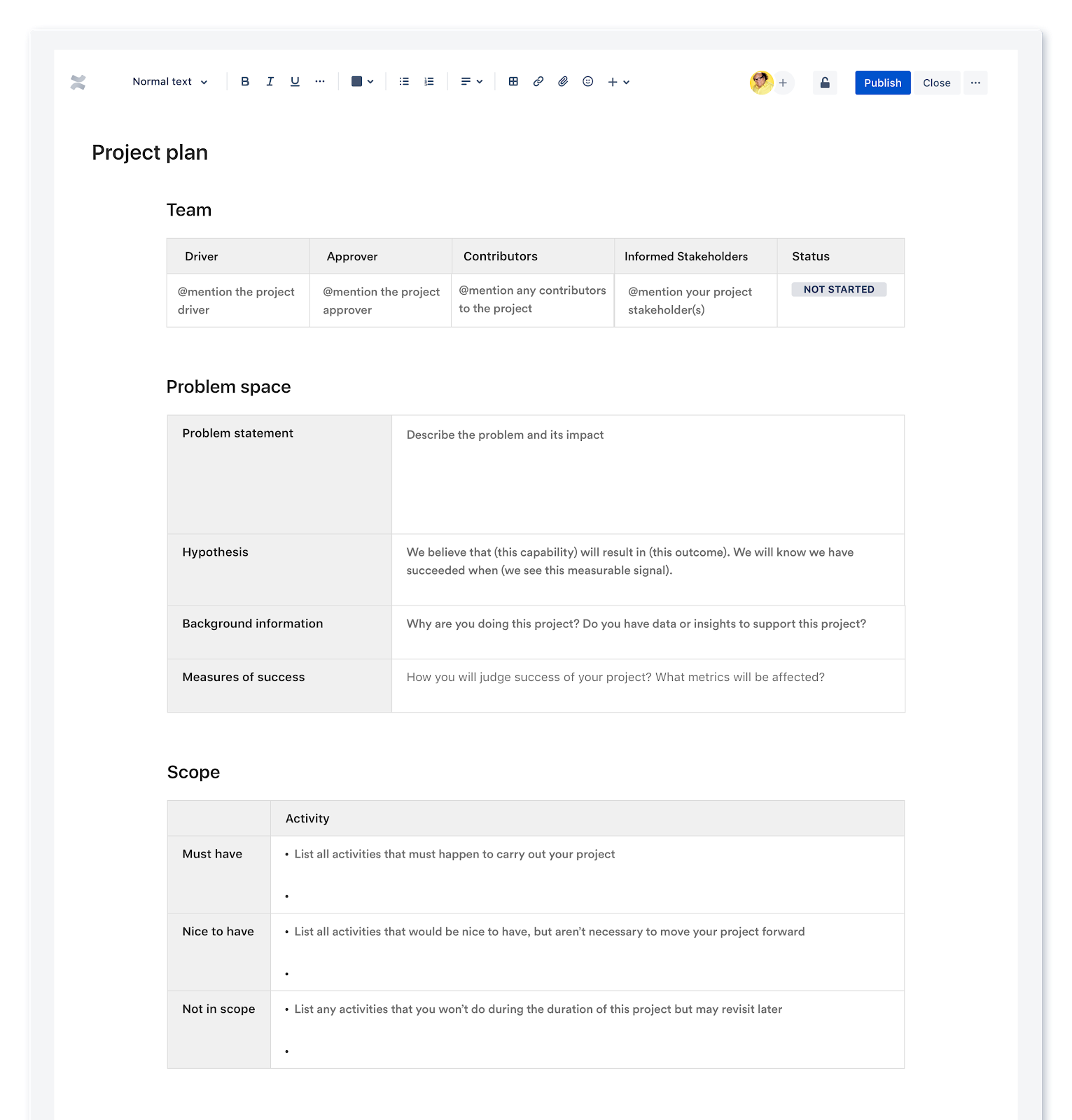How to create simple, robust project plans
Great project plans are more than a list of what to do and when
Просмотр тем
When most people hear “project plan,” they typically imagine a schedule—a laundry list of what to do and when. But that’s only a tiny part of it. A good project manager develops a plan that covers not only the problem they are trying to solve but also its scope, deliverables, risks, and project dependencies—charting a path to project success.
When there’s no project plan, team members can find themselves lost in a maze of complexities. They might not know where to begin, or even worse, they might dive into their tasks without clearly understanding how and when their work fits into the bigger picture.
Что такое планирование проекта?
Project planning is the process of defining the objectives, scope, and activities required to complete a project. It’s a fundamental aspect of project management that involves setting clear goals, identifying resources, estimating costs, and developing a roadmap for project success.
Project planning lays the foundation for effective execution, monitoring, and control. This process enables project managers and teams to align their efforts and resources, reducing uncertainty and increasing the chances of delivering a project on time and within budget.
What is a project plan?
A project plan is the tangible outcome of the project planning process. It is a comprehensive document that outlines the project’s key elements, including its goals and objectives, scope, schedule, resource requirements, risks, and dependencies.
A project plan serves as a roadmap for all stakeholders, providing a clear understanding of the project’s purpose, milestones, and expected outcomes. It names team members, specifies necessary project planning tools, and details the steps required to succeed.
A well-structured project plan not only guides project execution but also serves as a communication tool to keep everyone informed and aligned throughout a project’s lifecycle.
Benefits of project planning
- Clarity and alignment: Project planning provides a shared understanding of project objectives and scope, ensuring all team members and stakeholders are on the same page. This clarity reduces misunderstandings and conflicting expectations.
- Resource allocation: It helps in identifying and allocating the required resources, whether they are human, financial, or material. This optimizes resource utilization and prevents overallocation.
- Risk management: Project planning allows for the identification and assessment of potential risks. By planning for risks, the project team can proactively address and mitigate them.
- Time management: A well-structured project plan includes a timeline with milestones and task dependencies, making it easier to manage project schedules and meet deadlines.
- Cost control: By estimating project costs during a project’s planning phase, organizations can track and control expenses more effectively.
- Improved communication: The project plan serves as a communication tool that keeps all stakeholders informed, ensuring that everyone is aware of project progress, changes, and issues.
- Quality assurance: Planning can include quality standards and processes to ensure that the project delivers high-quality results.
- Increased accountability: Project plans designate task owners, making it clear who is responsible for specific activities, promoting accountability.
- Efficient decision-making: Planning helps define decision-making processes, making it easier to address issues and make critical decisions as they arise during the project.
Project planning process (with steps)
Using a step-by-step approach to creating a project plan might seem like putting a hat on a hat, but it’s critical to building a solid and successful strategy. Before diving into the planning process, take some time to reflect on your team, organization, available resources, and project goals. It’s essential to foster a shared understanding with your team right from the beginning of the project planning phase.
Step 1: Think of your project plan as a map
Составляя карту, полезно задать себе следующие вопросы:
- What is the destination?
- Как вы поймете, что проект завершен?
- Кто пойдет по этой карте?
- What milestones will they pass along the way?
- What obstacles might they encounter?
Are there any alternate routes available?
Шаг 2. Познакомьтесь с заинтересованными сторонами.
Get a read on organizational politics, difficult personalities, and possible debate points that may arise during the project management process. Larry W. Smith, PMP, Project Manager at the Software Technology Support Center, stresses the importance of stakeholder analysis. According to Smith, everyone wants the project to succeed, but forgetting to meet the needs of just one influential stakeholder could derail even the best-laid plans.
Смит рекомендует уделить время следующему:
- Уточнить, кто заинтересованные стороны проекта.
- Понять их ожидания и уровень влияния.
- Решить, как реализовывать обратную связь от коллег и заинтересованных сторон по мере продвижения проекта.
- Соотнести все потребности и ожидания с мероприятиями по планированию рисков и реагированию на риски.
- Добросовестно спланировать все стратегии коммуникации в рамках проекта.
You can't overstate the importance of clear communication. That’s why Bernie Ferguson, Atlassian’s resident project leadership expert, starts communicating with stakeholders in the earliest stages of a project:
“We use the Project Poster technique to build a shared understanding amongst team members and stakeholders. What are we doing? What’s the value to customers and to the business? Why do we think this is the right solution? We get feedback on the answers to all these questions before anything hits the team’s roadmap.” —Bernie Ferguson, Atlassian
Шаг 3. Без лишних иллюзий составьте календарный график работ.
Project managers often make the mistake of being overly optimistic. Rather than focusing on the best possible outcome, PMs should consider problems that might arise and how they impact the project management timeline.
Performing essential due diligence, holding a “pre-mortem” workshop, or conducting one-on-one meetings with key stakeholders is a great way to identify potential roadblocks.
Consider sketching out a timeline by asking other project managers how long similar projects took to plan. Meet with teams you’ll work with to understand how long specific project tasks will take. Use project management tools and search project archives for old project schedules.

Emphasize the importance of communication by reiterating its significance. Keep all relevant parties informed about the project’s details because, after all, wouldn’t you want to be in the know? Simplified Gantt charts are an effective way of visualizing a project’s timeline so it’s easy for everyone to understand.
Step 4: Recruit friends and colleagues
As the project manager, it’s up to you to deliver the project plan (and, ultimately, the project). But this isn’t about you going off into a cubicle and writing the thing. As you develop the project plan, you must keep all key stakeholders involved. Stay in near-constant contact. You’ll find they’re excellent resources.
By gathering your team’s thoughts and brainstorming ideas together, you can arrive at meaningful conclusions quickly. Team collaboration fosters a sense of communal support and, therefore, yields better project plans.
At Atlassian, we use templates to reduce the overhead associated with the planning process and trigger discussions essential to project-planning best practices. Project plan templates are an excellent way to get people to think about aspects of project management that they may have yet to consider.
Having a good elevator pitch for your project is one thing, but creating a robust and effective plan is an entirely different undertaking. Let’s face it: Mapping out project risks and dependencies isn’t much fun. Atlassian’s powerful templates and helpful prompts allow project managers to think methodically about project plan creation, leading to fewer oversights and enhanced productivity.

Step 5: Think through goals and project scope
Create a problem statement that defines, in no uncertain terms, exactly what you’re trying to accomplish. Next, develop a hypothesis that states what you think should happen due to solving your problem. Then, provide a brief overview of the project’s context and any relevant data or insights that support it. Finally, establish the key metrics you will use to gauge the project’s success. These success metrics are likely to influence various aspects of your plan, shaping its direction and focus.
Ask your team members what they need, as opposed to what’s nice to have or unnecessary. Establishing a clear understanding of the project’s scope early in the planning process, including what is explicitly excluded, minimizes the risk of stakeholder miscommunication. It also aids in determining the appropriate time allocation for project contributors. This clarity makes it easier to identify and manage any changes in the project’s scope as they arise.
Step 6: Anticipate surprises
Nearly all project plans include details about budgets, project schedules, and scope. But a great plan also answers essential questions about your project, including:
- Resources: What types of skills does the project demand? Who’s available? What’s our budget?
- Decisions: Who will make recommendations? Who will approve or disapprove requests?
- Communications: Who will be responsible for communicating progress and roadblocks?
- Risk: What should team members watch out for? What’s the process for logging and tracking threats?
- Reviews: How are you going to gather feedback before the project ships?
- Approvals: Who else needs to sign off on this? Who is the final decision maker?
Timing: Do team members’ work schedules fit the project timeline? How was the deadline chosen?
В плане не нужно вдаваться в подробности по каждому из этих вопросов, но в нем должно быть достаточно информации, чтобы вы могли беспрепятственно реализовать проект без особых сюрпризов.
Галочка Совет. Воспользуйтесь методом DACI для своевременного принятия обоснованных решений по проекту.
Совет. Воспользуйтесь методом DACI для своевременного принятия обоснованных решений по проекту.
Step 7: Choose a project management approach
Most PMs choose between a waterfall or agile approach to project management. An agile approach delivers results quickly through an iterative process that continuously evaluates project plans, requirements, and results. In this method, we consider time and resources as fixed.
The waterfall approach is a linear, sequential process that moves a project forward stage by stage, team by team. Here, we consider the scope to be fixed while timing and resources remain flexible.
Шаг 8. Напишите и проверьте план.
После того как вы ответили на все вопросы, провели все обсуждения и создали ворох стикеров, пришло время написать план проекта. При его написании и оформлении придерживайтесь принципа «чем проще — тем лучше».
Here are some helpful details that should be part of any plan:
- Название проекта
- Срок сдачи
- бюджет;
- Цели плана
- Обозначенные контрольные точки и ожидаемое измеримое воздействие
- Запланированные сроки начала и завершения каждого задания
- Выноски с указанием исполнителей отдельных заданий
- Подробности заданий и уточняющие замечания
Выноски, в которых указаны зависящие друг от друга риски и задания (или команды) с целью предотвращения задержек
When your project plan is finished, take a moment to ask someone who has yet to be involved in the writing process to review it. Having a second pair of eyes can help spot natural human errors.
Галочка Tip: When estimating each task’s size, resist the temptation to go deep into the weeds. Remember, these are educated guesses.
Tip: When estimating each task’s size, resist the temptation to go deep into the weeds. Remember, these are educated guesses.
Step 9: Share your plan for the world to see!
Once your project plan is finalized and thoroughly reviewed, it’s time to share it with the individuals actively involved and the stakeholders who need to stay informed. Prepare for an exciting project kick-off that sets the wheels in motion. It’s essential to be aware that changes and challenges are an integral part of any project, so being prepared to manage them is crucial.
Throughout the project lifecycle, maintain close contact with your plan. Stay focused on core project elements, the intended scope, and the agreed-upon steps. This approach ensures that you stay on track and increases the likelihood of successfully delivering your project, even in the face of unexpected developments.
Example of a project plan
Here is a simplified example of a project plan for a marketing campaign:
Project Name: Spring Product Launch Campaign
- Project goals and objectives:
- Increase brand visibility by 20%.
- Generate 1,000 leads within three months.
- Boost sales revenue by 15% during the spring season.
- Scope:
- Create a series of online and offline marketing materials.
- Launch a new product line.
- Run digital advertising campaigns.
- Project schedule:
- Phase 1 (Month 1-2): Campaign strategy and content creation.
- Phase 2 (Month 3): Launch and marketing rollout.
- Resources:
- Marketing team (4 members).
- $50,000 budget for advertising and materials.
- Risks:
- Unpredictable weather affecting outdoor events.
- Market competition leads to price wars.
- Dependencies:
- Completion of product development (before campaign launch).
- Availability of marketing materials (before advertising).
- Quality assurance:
- Regular reviews and feedback sessions to ensure high-quality content.
- Task owners:
- Campaign strategy: Sarah
- Content creation: John
- Product launch: Emily
Advertising campaigns: Mark
This example plan covers project goals, scope, timeline, resources, risks, dependencies, and quality measures, making it a valuable reference for stakeholders and project team members throughout the campaign.
Crafting effective project plans
In the realm of project management, a comprehensive and well-structured project plan is the compass that guides teams and stakeholders toward successful project completion. Project planning is not merely a checklist of tasks but an intricate process that defines project objectives allocates resources, assesses risks, and provides a roadmap for success.
By taking a thoughtful, step-by-step approach, project managers can foster clarity, collaboration, and adaptability throughout the project’s lifecycle, ultimately enhancing the chances of delivering projects on time and within budget.
